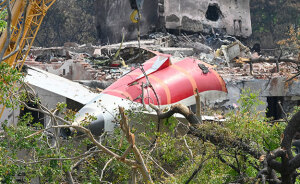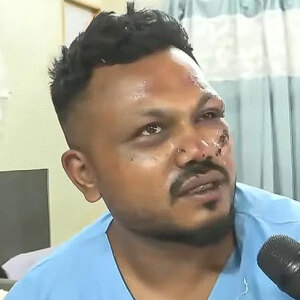With 78,801 photos submitted by 4,738 photographers, the 2019 World Press Photo of the Year Contest can only have winners of the very highest caliber. These hard-hitting images, taken by professional photo-journalists from all over the world, tell us the stories that matter, getting to the heart of the issues facing our world and opening our eyes to the often harsh reality.
This year's winner is a heartbreaking photo of 2-year-old Honduran toddler Yanela Sanchez, who is captured crying as she and her mother, Sandra Sanchez, are taken into custody by US border officials in McAllen, Texas. The photo, which went viral and sparked a major debate, was taken by Getty Images photographer John Moore, who described the experience in an interview with NPR. "I could see the fear on their faces, in their eyes," the award-winning photographer said. "As the Border Patrol took people's names down, I could see a mother holding a young child."
As Sandra and Yanela were being processed and searched, officers asked the mother to set the child aside. "At that moment, the young child broke into tears, and she started wailing," Moore said. "I took a knee and had very few frames of that moment before it was over."
It was an unhappy end to a long an emotional journey for mother and daughter, attempting to make a better life for themselves after their own country of Honduras has descended into poverty and violence, due in no small part to U.S. policies over the years. Moore knew that for the pair, some painful times could lie ahead. “Most of us here had heard the news that the Trump administration had planned to separate families. And these people really had no idea about this news. And it was hard to take these pictures, knowing what was coming next.”
As the immigration debate intensified, the image of the tearful girl was juxtaposed against a stern-looking Donald Trump on the cover of the July 2018 edition of TIME magazine, alongside the caption: Welcome to America. Later on, it emerged that mother and daughter weren't actually split up on this occasion, leading many to accuse the photo of promoting a false narrative. Moore confirmed to CBS News that the agents he observed that night acted professionally but says he’s still pleased with both the response to his photo and the TIME cover image.
“Oftentimes, immigration is talked about in terms of statistics, and when you put a human face and humanize an issue, you make people feel,” Moore says. “And when you make people feel, they have compassion. And if I’ve done just a little bit of that, then that’s OK.”
Despite the controversy surrounding it, the judges felt that the powerful image was symbolic of the wider issue at hand, and more than merited the award.
Scroll down to see other winners in the prestigious contest, which has been running since 1955, and let us know your favorites in the comments!
This post may include affiliate links.
Environment, Singles, 1st Prize. "Akashinga - The Brave Ones" By Brent Stirton
Petronella Chigumbura (30), a member of an all-female anti-poaching unit called Akashinga, participates in stealth and concealment training in the Phundundu Wildlife Park, Zimbabwe.
Akashinga (‘The Brave Ones’) is a ranger force established as an alternative conservation model. It aims to work with, rather than against local populations, for the long-term benefits of their communities and the environment. Akashinga comprises women from disadvantaged backgrounds, empowering them, offering jobs, and helping local people to benefit directly from the preservation of wildlife. Other strategies—such as using fees from trophy hunting to fund conservation—have been criticized for imposing solutions from the outside and excluding the needs of local people.
This sounds like a good initiative--to work with the communities--to make it more valuable to protect the animals--that looks like a good, positive way forward.
Contemporary Issues, Singles, 2nd Prize, "Male Rape" By Mary F. Calvert
Former US marine Ethan Hanson bathes at home in Austin, Minnesota, USA, after a sexual trauma experienced during his military service left him unable to take showers.
During a boot camp, Ethan and fellow recruits were ordered to walk naked through a communal shower while pressed together. Ethan reported the incident, but was harassed by the other men for doing so. Nightmares and panic attacks later forced him to resign. Recent Defense Department figures show sexual assault in the military to be on the increase. Servicemen are less likely than women to report sexual trauma, fearing retaliation or stigma.
Nature, Singles, 2nd Prize, "Flamingo Socks" By V
Caribbean flamingo inspects the improvised socks created to help heal its severe foot lesions, at the Fundashon Dier en Onderwijs Cariben, Curaçao.
The bird was brought by plane from neighboring island Bonaire, after spending a few weeks in a local rehabilitation facility. Such lesions are common among captive flamingos, as they have very sensitive feet and are used to walking on soft ground. After a few weeks of care the bird was transported back to Bonaire. There are around 3,000 breeding pairs of Caribbean flamingos on Bonaire, and a further 200 to 300 birds on Curaçao.
Spot News, Singles, 1st Prize, "Crying Girl On The Border" By John Moore
Immigrant families had rafted across the Rio Grande from Mexico and were then detained by US authorities. Sandra Sanchez said that she and her daughter had been traveling for a month through Central America and Mexico before reaching the US to seek asylum. The Trump Administration had announced a ‘zero tolerance’ policy at the border under which immigrants caught entering the US could be criminally prosecuted. As a result, many apprehended parents were separated from their children, often sent to different detention facilities. After this picture was published worldwide, US Customs and Border Protection confirmed that Yanela and her mother had not been among the thousands who had been separated by US officials. Nevertheless, public outcry over the controversial practice resulted in President Donald Trump reversing the policy on 20 June.
Nature, Stories, 2nd Prize, "Meet Bob" By Jasper Doest
Bob, a rescued Caribbean flamingo, lives among humans on the Dutch island of Curaçao. Bob was badly injured when he flew into a hotel window, and was cared for by Odette Doest who runs Fundashon Dier en Onderwijs Cariben (FDOC), a wildlife rehabilitation center. During Bob’s rehabilitation, Odette discovered that he had been habituated to humans, and so would not survive if returned to the wild. Instead, he became an ‘ambassador’ for FDOC, which educates local people about the importance of protecting the island’s wildl
The cat has just realized that his/her past hunting sins have caught up to them.
Nature, Stories, 3rd Prize, "Wild Pumas Of Patagonia" By Ingo Arndt
Pumas, also known as mountain lions or cougars, are found from the Canadian Yukon to the southern Andes, the widest range of any large wild mammal in the Western Hemisphere. They can survive in a variety of habitats, from deserts and prairies to forests and snowy mountains, but are generally shy and elusive to humans. The Torres del Paine region in Chilean Patagonia is thought to contain higher concentrations of pumas than anywhere else in the world. Pumas are ambush predators, stalking their prey from a distance for an hour or more before attacking. In Torres del Paine, pumas feed mainly on guanacos, which are closely related to llamas.
Portraits, Singles, 3rd Prize, "When I Was Ill" By Alyona Kochetkova
Alyona Kochetkova sits at home, unable to face borscht (beet soup), her favorite food, during treatment for cancer.
Alyona shot this self-portrait following surgery and chemotherapy, when, although she knew the vital importance of food, she struggled to eat. Taking photos was not only a way of sharing a difficult and personal story in the hope that it might support others with a cancer diagnosis, it was also a means of accepting her ordeal by doing what she loved.
Sports, Stories, 2nd Prize, "Never Saw Him Cry" By Michael Hanke
Zdenĕk Šafránek is the captain of the Czech Republic Para Ice Hockey team, and has participated in three Paralympic Games. He has been in a wheelchair since an accident at work in an auto repair shop in 2003. He also represents his country in mountain biking and handcycling, and in 2017–18 was the Czech Republic’s champion paraboxer. Šafránek lives in the town of Pátek, near Podĕbrady, in the Czech Republic, with his partner and three children.
Contemporary Issues, Singles, 3rd Prize, "Afghan Refugees Waiting To Cross The Iranian Border" By Enayat Asadi
An Afghan refugee comforts his companion while waiting for transport across the eastern border of Iran, on 27 July.
UNHCR reports that Iran has almost one million registered refugees, the vast majority from Afghanistan. In addition, more than 1.5 million undocumented Afghans are estimated to be present in the country. Many people fleeing violence, insecurity and poverty in Afghanistan find no alternative but to use illegal traffickers, along routes where they are exposed to robbery, kidnapping and death. Their aim is to pass through Iran and Turkey or Greece to seek a better life elsewhere, but trafficked refugees are highly vulnerable to forced labor, debt bondage, forced marriage, or work in the sex trade.
Environment, Singles, 3rd Prize, "Living Among What's Left Behind" By Mário Cruz
A child who collects recyclable material lies on a mattress surrounded by garbage
floating on the Pasig River, in Manila, Philippines.
The Pasig River was declared biologically dead in the 1990s, due to a combination
of industrial pollution and waste being dumped by nearby communities living without adequate sanitation infrastructure. A 2017 report by Nature Communications cites the Pasig as one of 20 most polluted rivers in the world, with up to 63,700 tons of plastic deposited into the ocean each year. Efforts are being made to clean up the Pasig, which were recognized by an international prize in 2018, but in parts of the river the waste is still so dense that it is possible to walk on top of the garbage.
Contemporary Issues, Singles, 1st Prize, "The Cubanitas" By Diana Markosian
Pura rides around her neighborhood in a pink 1950s convertible, as the community gathers to celebrate her fifteenth birthday, in Havana, Cuba.
A girl’s quinceañera (fifteenth birthday) is a Latino coming-of-age tradition marking transition into womanhood. It is a gender specific rite of passage, traditionally showcasing a girl’s purity and readiness for marriage. Families go to great expense, often celebrating with a lavish party. The girl dresses as a princess, living out a fantasy and perceived idea of femininity. In Cuba, the tradition has transformed into a performance involving photo and video shoots, often documented in a photobook. Pura’s quinceañera had a special poignancy, as some years earlier, having been diagnosed with a brain tumor, she was told she would not live beyond the age of 13.
Portraits, Singles, 1st Prize, "Dakar Fashion" By Finbarr O'reilly
Diarra Ndiaye, Ndeye Fatou Mbaye and Mariza Sakho model outfits by designer Adama Paris, in the Medina neighborhood of the Senegalese capital, Dakar, as curious residents look on.
Dakar is a growing hub of Franco-African fashion, and is home to Fashion Africa TV, the first station entirely dedicated to fashion on the continent. The annual Dakar Fashion Week includes an extravagant street show that is open to all and attended by thousands from all corners of the capital. Adama Paris (who has a namesake brand) is a driving force behind the fashion week, and much else on the design sce
Contemporary Issues, Stories, 2nd Prize, "Colombia, (Re)birth" By Catalina Martin-Chico
Angelina was among the first former guerrillas to become pregnant in the FARC transition camp in San José del Guaviare, Colombia. She joined FARC at the age of 11, calling herself ‘Olga’, after her stepfather had attempted to abuse her.
Since the signing of a peace agreement between the Colombian government and the FARC rebel movement in 2016, there has been a baby boom among former female guerrillas, many living in the demobilization camps set up to help FARC members in the transition back to everyday life. Pregnancy was thought incompatible with guerrilla life. Women were obliged to put war before children, leaving babies with relatives or, some say, undergoing forced abortions—a charge FARC denies.
Environment, Stories, 2nd Prize, "God’s Honey" By Nadia Shira Cohen
Beekeepers, led by Russel Armin Balan, tend their hives in Tinúm, Yucatán, Mexico.
Mennonite farmers growing soy in Campeche, on the Yucatán Peninsula in Mexico, are allegedly adversely impacting the livelihood of local Mayan beekeepers. The Mennonites farm large tracts of land in the area. Environmental groups and honey producers say that the introduction of genetically modified soy and use of the agrochemical glyphosate endangers health, contaminates crops, and reduces the market value of honey by threatening its ‘organic’ label. Soy production also leads to deforestation, as land is increasingly bought for farming, further affecting bee populations.
This needs to be given the attention it deserves. This is a man-made disaster caused by people moving into an eco-system they don't understand, with devastating results. The mayans have been there for thousands of years. We need bees to live, the whole planet does. We do not need soy.
Portraits, Stories, 3rd Prize, "Falleras" By Luisa Dörr
Women and girls wear fallera dresses for the Fallas de Valencia festival in Valencia, Spain. Inspired by clothes worn centuries ago by women working in rice fields around the city, the dresses have changed over time and are now elaborate creations that can cost in excess of €1,000. Made mainly of lace and silk, fallera dresses are worn by anyone who wants to take part in what is one of Spain’s biggest street festivals. To complement the gown, falleras set their hair in a traditional three-bun style adorned with ornate combs and jewellery, often handed down through generations. Different parts of the city each have a fallera mayor (and maybe also a young fallera mayor infantil)—a woman who represents her falla (neighborhood group) at the festivities. It is an honor to be chosen, and can mean even greater expense being lavished on the outfit.
Contemporary Issues, Stories, 3rd Prize, "Faces Of An Epidemic" By Philip Montgomery
The body of Brian Malmsbury is taken away after he overdosed on heroin in the basement of his family’s home, Miamisburg, Ohio, USA.
According to the National Institute on Drug Abuse, more than 130 people a day in the US die after overdosing on opioids. President Donald Trump has declared the opioid epidemic a national public health emergency. The crisis has its roots in the 1990s, when pharmaceutical companies assured doctors that opioid pain relievers were not addictive. The firm Purdue Pharma, in particular, has been accused of aggressive marketing even when the effects of opioids were known. Increased prescription of opioids such as Oxycontin led to widespread misuse. Some people switched to heroin, which was cheaper, and later to synthetic opioids, which are more potent and more likely to lead to a fatal overdose.
And nothing being done. A humanitarian crisis in the middle of one of the wealthiest countries in the world that has destroyed hundreds of thousands of lives; instead, hundreds of millions to go to a ineffective border wall for a problem that does not exist. The evil-doers and drug pushers are inside the US--Purdue Pharmacy.
Contemporary Issues, Stories, 1st Prize, Blessed Be The Fruit: Ireland's Struggle To Overturn Anti-Abortion Laws" By Olivia Harris
Graffiti artist Shirani Bolle paints a portrait of Savita Halappanavar, who died in 2012 after being refused an abortion, in Dublin, Ireland.
On 25 May, Ireland voted by a large majority to overturn its abortion laws, which were among the most restrictive in the world. A 1983 referendum had resulted in an Eighth Amendment to the Irish constitution reinforcing a ban on terminations, even those resulting from rape and incest. Prior to the referendum, an estimated 3,000 women traveled to the UK annually for abortions. In 2012, the death of Savita Halappanavar from sepsis after doctors had denied her a termination, shocked Ireland and galvanized campaigners calling for an end to the ban. Her name became synonymous with the movement to repeal the Eighth Amendment. The campaign broadened, arguing that restrictions on women impact everyone in society, and that the support of men, too, was necessary to effect change. Campaigners used social media platforms to spread their message, and took the argument to the streets in the form of demonstrations and theatrical spectacle. Nearly two thirds of the Irish population turned out to participate in the referendum, with 66.4 percent voting to overturn the abortion prohibition. By the end of the year, the Irish president had signed a new bill into law, making abortion for any pregnancy less than 12 weeks available without cost.
Change can be achieved. Witness what these women have achieved over what appeared to be insurmountable odds.
Spot News, Stories, 2nd Prize, "Syria, No Exit" By Mohammed Badra
By February 2018, the people of Eastern Ghouta, a suburban district outside Damascus and one of the last rebel enclaves in the ongoing Syrian conflict, had been under siege by government forces for five years. During the final offensive, Eastern Ghouta came under rocket fire and air bombardment, including at least one alleged gas attack—on the village of al-Shifunieh, on 25 February. Figures are difficult to verify, but Médecins Sans Frontiѐres (MSF) reported 4,829 wounded and 1,005 killed between 18 February and 3 March, according to data from medical facilities they supported alone. MSF also reported 13 hospitals and clinics damaged or destroyed in just three days. Reports on the end of the siege in Eastern Ghouta are conflicting, though the Syrian army appear to have recaptured most of the south of the country by July. UNICEF reported the siege of Eastern Ghouta to have ended by late March, with limited humanitarian access becoming available.
Environment, Singles, 2nd Prize, "Evacuated" By Wally Skalij
Evacuated horses stand tied to a pole, as smoke from a wildfire billows above them, on Zuma
Beach, in Malibu, California, USA, on 10 November.
The 2018 wildfire season in California was the deadliest and most destructive on record,
burning an area of more than 676,000 hectares. While scientists pointed to the effects of
climate change as a cause, US President Donald Trump blamed forest management.
Nature, Singles, 3rd Prize, "Glass Butterfly" By Angel Fitor
A winged comb jelly, Leucothea multicornis, its wings widely opened, propels itself through
waters off Alicante, Spain.
Leucothea multicornis, like other comb jellies, is a voracious predator, capturing its prey
using sticky cells rather than by stinging. Little is currently known about the biology of comb
jellies. Because the creatures are so fragile and fold their wings in reaction to the slightest
vibration, they are extremely difficult to study and to photograph.
General News, Singles, 2nd Prize, "Still Life Volcano" By Daniele Volpe
The living-room of an abandoned home in San Miguel Los Lotes, Guatemala, lies covered in ash after the eruption of Volcán de Fuego on 3 June.
Fuego, around 40 km southwest of the capital Guatemala City, is one of Latin America’s most active volcanoes, and has been erupting periodically since 2002. It is monitored by volcanologists, but this eruption came without warning. People living around the volcano, many at Sunday lunch, were surprised by the suddenness of the event, as Fuego spewed red-hot lava, ash, poisonous gases and flaming debris onto villages below. The eruption was one of the deadliest in Guatemala for over a century. Guatemala’s National Institute of Forensic Sciences reported the recovery of 318 bodies, over a third of them unidentified.
Spot News, Stories, 1st Prize, "The Migrant Caravan" By Pieter Ten Hoopen
During October and November, thousands of Central American migrants joined a caravan heading to the United States border. The caravan, assembled through a grassroots social media campaign, left San Pedro Sula, Honduras, on 12 October, and as word spread drew people from Nicaragua, El Salvador and Guatemala. They were a mix of those facing political repression and violence, and those fleeing harsh economic conditions in the hope of a better life. Traveling in a caravan offered a degree of safety on a route where migrants have previously disappeared or been kidnapped, and was an alternative to paying high rates to people smugglers. Migrant caravans travel to the US border at different times each year, but this was the largest in recent memory with as many as 7,000 travelers, including at least 2,300 children, according to UN agencies. Conditions along the way were grueling, with people walking around 30 km a day, often in temperatures above 30°C. The caravan usually set off at around 4am each day to avoid the heat. Like others, the caravan drew condemnation from US president Donald Trump, who made it a focal point of rallies and used it to reiterate his call for tough immigration policies and the building of a border wall.
Amazed at the lack of compassion. Asylum is legal. People will try anything to build a better and safer life. Our responsibility as a country is to find a legal, compassionate, and kind path too legal immigration. One more time what asylum sealers are doing is legal. Even if it were not punishment must fit the crime. Running from danger should not equal this.
Portraits, Stories, 2nd Prize, "Northwest Passages" By Jessica Dimmock
Transgender individuals around the world are still exposed to widespread social stigma and abuse. For many transgender women, coming to terms with their female selves is an ongoing process. Some find resourceful ways in which to express their identities in private. Senior transgender women in northwestern USA are pictured in the places where they hid their female identities for decades.
So many cisgender people lack the understanding of what it's like to feel gender dysphoria. It's been described as 'being in the wrong body'. Just imagine waking up, and everything about you is wrong. Your chest is too big or too flat, and your arms are too thin or too muscular. It's the worst, most inhibiting feeling in the world, and no one deserves to feel that, added with the social prejudice that it brings on.
Long-Term Projects, Stories, 1st Prize, "Beckon Us From Home" By Sarah Blesener
Patriotic education, often with a military subtext, forms the mainspring of many youth programs in both Russia and the United States. In America, the dual messages of ‘America first’ and ‘Americanism’ can be found not only as a driving force behind adult political movements, but around the country in camps and clubs where young people are taught what it means to be an American. In Russia, patriotic clubs and camps are encouraged by government. In 2015, President Vladimir Putin ordered the creation of a Russian students’ movement whose aim was to help form the characters of young people through instruction in ideology, religion and preparedness for war. The ‘Patriotic Education of Russian Citizens in 2016–2020’ program called for an 8 percent increase in patriotism among youth, and a 10 percent increase in recruits to the armed forces.
The photographer visited ten youth programs in the US, as well as schools and military summer camps in Russia. The aim of the series is to use these young people and their lives as the focal point in an open dialogue around the ideas instilled in future generations, and examine how young people are responding to contemporary society.
Spot News, Stories, 3rd Prize, "Ambulance Bomb" By Andrew Quilty
An ambulance packed with explosives killed 103 people and injured 235 in Kabul, Afghanistan, on 27 January. The ambulance had passed through one security point unnoticed, but although the attacker was identified at a second checkpoint, he couldn’t be stopped from detonating his explosives. The bombing took place at lunchtime near Chicken Street, a central shopping area once popular among foreign nationals, and close to government and diplomatic buildings. The victims, however, were overwhelmingly Afghan civilians and police. The Taliban claimed responsibility for the ambulance bombing, which ranked among the worst civilian attacks in the Afghan capital in some years. Taliban commanders said they were intensifying urban attacks in retaliation for increased airstrikes on areas under their control.
It feels like nobody on earth cares about middle eastern people. It’s too bad the hicks don’t get deported to Afghanistan and traded for actual human beings from the region.
Nature, Stories, 1st Prize, "Falcons And The Arab Influence" By Brent Stirton
The millennia-old practice of falconry is experiencing an international resurgence, especially as a result of efforts in the Arab world. UNESCO now recognises falconry as an Intangible Cultural Heritage of Humanity (ICH), a status enjoyed by no other hunting sport. Falcons bred in captivity have helped diminish the trade in captured wild birds, including some species that are listed as endangered. But some falcons in the wild continue to be at risk from capture and other anthropogenic factors such as electrocution on badly designed powerlines, habitat degradation and agrochemicals. Similarly, although the breeding of birds such as houbara bustards for prey has made hunting a more sustainable practice, the British Ornithologists’ Union reported that the wild houbara population continued to decline
Portraits, Stories, 1st Prize, "Land Of Ibeji" By Bénédicte Kurzen And Sanne De Wilde
Nigeria has one of the highest occurrences of twins in the world, particularly among the Yoruba people in the southwest. In the southwestern town of Igbo-Ora, dubbed ‘The Nation’s Home of Twins’, reportedly almost every family has at least one set. In 2018, the town hosted a Twins Festival, attended by over 2,000 pairs. The first-born twin is usually called Taiwo, meaning ‘having the first taste of the world’, while the second-born is named Kehinde, ‘arriving after the other’. Communities have developed different cultural practices in response to this high birth rate, from veneration to demonization. In earlier times, twins in some regions were considered evil, and vilified or killed at birth. Nowadays, the arrival of twins is generally met with celebration, and many think they bring good luck and wealth. Two color filters were used, to express duality: of identity, of photographers, and of attitude to twins.
General News, Stories, 1st Prize, "Yemen Crisis" By Lorenzo Tugnoli
After nearly four years of conflict in Yemen, at least 8.4 million people are at risk of starvation and 22 million people—75% of the population—are in need of humanitarian assistance, according to the UN. In 2014, Houthi Shia Muslim rebels seized northern areas of the country, forcing the president, Abdrabbuh Mansour Hadi, into exile. The conflict spread, and escalated when Saudi Arabia, in coalition with eight other mostly Sunni Arab states, began air strikes against the Houthis. By 2018, the war had led to what the UN termed the world’s worst man-made humanitarian disaster. Saudi Arabia said that Iran—a Shia-majority state and their rival regional power—was backing the Houthis with weapons and supplies, a charge Iran denied. The Saudi-led coalition implemented a blockade on Yemen, imposing import restrictions on food, medicines and fuel. Resulting shortages exacerbated the humanitarian crisis. In many cases, conditions of near-famine were caused not so much by the unavailability of food, but because it became unaffordable, priced out of reach to most Yemenis by import restrictions, soaring transport costs due to fuel scarcity, a collapsing currency and other man-made supply disruptions.
delilah- about that separation of church and state here in the US... it sure as hell isn't working. All these awful things being done in the name of "religious freedom"? going great, thanks. and what about all of those churches that go tax free? Non-religious people aren't going without tax for things they do, and they help pay to make up for what the churches don't pay, which is unfair and unconstitutional. I'm sorry if I seem harsh, but it's true.
Nature, Singles, 1st Prize, "Harvesting Frogs’ Legs" By Bence Máté
Frogs with their legs severed and surrounded by frogspawn struggle to the surface, after being thrown back into the water in Covasna, Eastern Carpathians, Romania, in April.
Frogs’ legs are frequently harvested for food in the spring, when males and females gather to mate and spawn. Legs are sometimes severed while the animal is still living. About US$40 million worth are sold annually, with countries across the world participating in the trade. A small part of the population in the Carpathian Mountains make their living by collecting frogs’ legs in the wild and selling them.
Long-Term Projects, Stories, 2nd Prize, "The House That Bleeds" By Yael Martínez
Across Mexico, more than 37,400 people have been categorized as ‘missing’ by official sources. The vast majority of those are believed to be dead—victims of ongoing violence that has claimed more than 250,000 lives since 2006. These disappearances are the source of lasting psychological trauma for families left behind.
The violence has its roots in the war on Mexico’s powerful drugs cartels instigated by President Felipe Calderón during his 2006–2012 term of office, and continued by his successor, Enrique Peña Nieto. The ensuing violence has led to a catastrophic rise in murder rates and in the number of unsolved disappearances, which is aided by corruption and impunity. President Nieto promised an end to violence, but although homicides declined, authorities seemed unable to restore the rule of law or make much progress in the struggle against cartels. Among the states most affected are Sinaloa and Guerrero, which was included in a list of no-travel zones by the US government in 2018.
In 2013, one of the photographer’s brothers-in-law was killed and another two disappeared. This led him to begin documenting the resultant psychological and emotional fracture in his own family and in the families of other missing people, to give a personal account of the despair and sense of absence that accrues over time.
This is an absolute horrible thing. I live in Morelos (which is turning into high murder rate in Mexico) and you CAN REALLY feel the fear everyday. You can't truly know that you or you love ones would make it home at the end of day. Almost every night you.can hear gunshots and the best you can think is "hopefully it was just a robbery", and then you wake up and read on the newspaper that that same night someone was killed nearby you were, and there were more murders acrossed the state. And that's everyday, and it's turning into sometimes "normal", like people take it as it's going to happen to them someday. And that's just on my state, which is a really small one. Mexico is s real big country, so, imagine that, occurring just on a tiny spot, and then magnify it to the whole country.
horrors were shown. injustices were screamed out. i... i can't form words to express what i felt while looking at these photos. some were beautiful. some were strange. but the ones that hurt the most were the ones about the mistreatments of men, women, children, humans, people around the world.
You are right. And still historians say we live in a time when the least war, violence, death is happening in history relative to Earth population.
Load More Replies...Lewis Jones really must be a sad f**k to comment negatively on nearly all of the pictures.
A typical person who can't "do" anything, mired in idiotic propagandist regurgitations. Typical, frightened, ignorant. Sad.
Load More Replies...Oh the damage we do to each other. We are all human--these photos demonstrate that.
horrors were shown. injustices were screamed out. i... i can't form words to express what i felt while looking at these photos. some were beautiful. some were strange. but the ones that hurt the most were the ones about the mistreatments of men, women, children, humans, people around the world.
You are right. And still historians say we live in a time when the least war, violence, death is happening in history relative to Earth population.
Load More Replies...Lewis Jones really must be a sad f**k to comment negatively on nearly all of the pictures.
A typical person who can't "do" anything, mired in idiotic propagandist regurgitations. Typical, frightened, ignorant. Sad.
Load More Replies...Oh the damage we do to each other. We are all human--these photos demonstrate that.

 Dark Mode
Dark Mode 

 No fees, cancel anytime
No fees, cancel anytime 











































































































